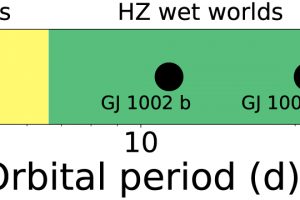Two terrestrial planets discovered in the habitable zone of the star GJ1002. The study: “Two temperate Earth-mass planets orbiting the nearby star GJ1002” of A. Suárez Mascareño (Istituto de Astrofisica de Canarias) appeaed on A&A

The search for terrestrial like exoplanets in the habitable zone of their stars is one of the most significant areas of exoplanetary science. The habitable zone is defined as the region around a given star where rocky planets are within the suitable temperature range to potentially support liquid water on their surfaces. Earth-like planets within habitable zones are therefore the primary targets for the search for habitable environments beyond the Solar System.
For several reasons, scientists involved in the search for Earth-like planets prefer to focus on M-type stars. One reason is that these stars have lower mass compared to solar-like stars, making it easier to detect the oscillations of these stars during the orbit of their planets using the radial velocity technique. This technique is a spectroscopic method aimed at detecting and measuring the oscillations of stars around the common center of mass with their planetary systems through Doppler effect measurements. Additionally, M-type stars are less luminous than more massive stars, resulting in habitable zones located closer to the star, which enhances the detectability of radial velocity signals. Lastly, M stars are the most common type of stars in our Galaxy, providing a larger and more diverse sample of potential targets for exoplanetary science.
It is not surprising, therefore, that several observational programs focusing on the search and characterization of exoplanets prioritize M-type stars. These programs include those conducted with the ESPRESSO spectrograph, installed on the Very Large Telescope of the European Southern Observatory, which is capable of measuring radial velocity signals as low as 10 cm/sec, or with CARMENES spectrograph, mounted on the telescope of the Centro Astronomico Hispano Aleman, designed for simultaneous observations in optical and infrared bands. This observing strategy is particularly effective in distinguishing planetary radial velocity signals from those caused by stellar magnetic activity. The team led by astronomer A. Suárez Mascareño (Istituto de Astrofisica de Canarias) analyzed a long time series of observations of the M5.5V star GJ1002, located approximately 16 light years away from the Sun. This analysis comprised 53 observations with ESPRESSO from January 2019 to December 2021, as well as 86 CARMENES observations collected between 2017 and 2019. The team successfully isolated the signals from two planets. Besides, by combining these observations with photometric data from the NASA satellite TESS, it was determined that the two planets have masses of 1.08 and 1.36 times that of Earth, and orbital periods of 10.3 and 20.2 days, respectively. These values indicate that the two planets are well within the habitable zone of GJ1002, where rocky planets are warm enough to potentially host liquid water on their surfaces. As stated by the authors, these planets are prime targets for next-generation telescopes such as the Extremely Large Telescope, in order to further investigate their potential habitability. The study, titled “Two temperate Earth-mass planets orbiting the nearby star GJ1002” was recently published in the journal Astronomy & Astrophysics. The list of co-authors also includes astronomers G. Micela and S. Benatti from INAF – Astronomical Observatory of Palermo.
The image illustrates the position of the two planets within the habitable zone of GJ1002, distinguishing regions expected to be populated by “dry worlds” and “wet worlds” (following the definitions provided by previous studies). In the red and blue regions, respectively, the surface temperatures of rocky planets are expected to be too hot or too cold to sustain liquid water. [Click here to view the complete image.]
Mario Giuseppe Guarcello ( follow mariospiegacose) ( mariospiegacose) ( follow mariospiegacose)
Follow the Astronomical Observatory of Palermo on Facebok and on Instagram
Subscribe the Youtube channel of the Astronomical Observatory of Palermo
